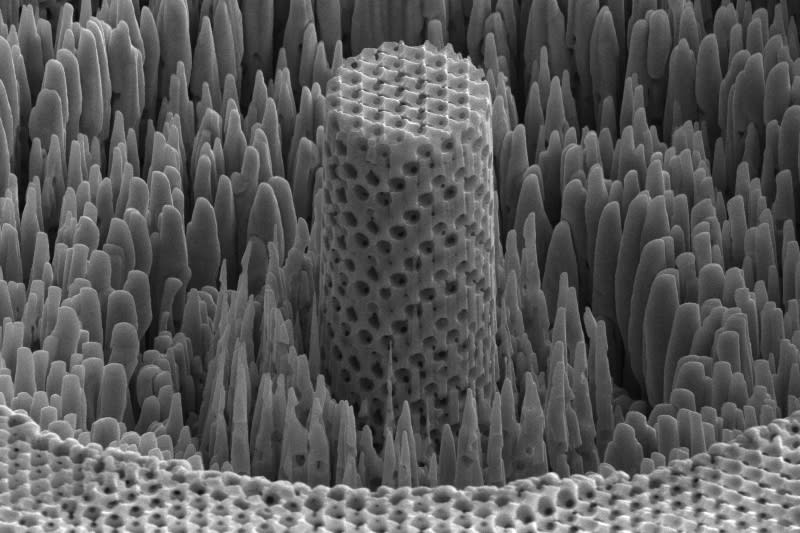Researchers have built a material as strong as titanium, but four to five times lighter – and porous.
The metal, developed by teams from the University of Pennsylvania , the University of Illinois at Urbana–Champaign, and the University of Cambridge, has areas both dense with struts and porous with air gaps. The empty spaces give the material natural, wood-like properties.
“We have a structure that’s kind of like a foam of really strong steel,” said James Pikul, research lead and Assistant Professor at the University of Pennsylvania’s Department of Mechanical Engineering and Applied Mechanics.

The pores also provide pockets for new functions.
“You could have liquids in this porous structure; you could transport ions in it,” Pikul told Tech Briefs. “We’ve turned some of these materials into batteries before.”
The struts in the researchers’ metallic wood are approximately 10 nanometers wide, or about 100 nickel atoms across.
To create the titanium-like structure, Pikul and his team suspended tiny plastic spheres, a few hundred nanometers in diameter, in water. After evaporation, the spheres settled and stacked like cannonballs, providing an orderly, crystalline framework.
Using electroplating – the same process used to add chrome to a hubcap – the team then infiltrated the plastic spheres with nickel. With the nickel in place, the plastic spheres were dissolved with a solvent, leaving an open network of metallic struts.
Most example-products made from strong materials have been about the size of a mosquito, according to Pikul. With the metallic wood, the professor says they can make metallic wood samples that are 400 times larger.
"We’ve known that going smaller gets you stronger for some time,” Pikul said, “but people haven’t been able to make these structures with strong materials that are big enough that you’d be able to do something useful.”
Because roughly 70 percent of the researchers’ material is empty space, the nickel-based metallic wood’s density is also extremely low in relation to its strength.
Pikul spoke with Tech Briefs about what you can do with a metal that has that kind of water-like density.
Tech Briefs: What is special about your material compared to, say, titanium?
Professor James Pikul: It’s porous. I think that’s probably the most unique feature. Titanium and most metals you use are usually not porous. We make our material from nickel. It’s much heavier than titanium. Titanium, as it’s used in practice, is usually some sort of alloy of different materials. In our system, we are using pure nickel.
We add nanoscale pores into it in a very controlled way that locally strengthens the connecting ligaments in this pore network. You can think of it like a scaffolding. If you were to build a building, you would start by building up a whole bunch of steel beams that connect each other.
Our nickel beams are all connected, but they are tens of nanometers in diameter. When you make the pores at the nanoscale, you get the strengthening effect, which allows this high strength and low weight.
Tech Briefs: How is the material like wood?
Prof. Pikul: First, it’s cellular, meaning it basically has porous structures. In our case, the pore structures are connected to each other.
Wood needs to have that cellular architecture because it starts out as a living organism. Wood needs the pores to transport proteins and energy in order for the tree to grow. The pores are the weaker part, but that allows all the energy and nutrients to be moved around. There is a strength around the pores of the wood.
Our system is similar. We have a structure that’s kind of like a foam of really strong steel. You could have liquids in this porous structure; you could transport ions in it. We’ve turned some of these materials into batteries before.
It’s also a structural material. It’s designed to hold mechanical loads, and wood also holds mechanical loads.

Tech Briefs: How are you testing the material now?
Prof. Pikul: Right now we’re studying some of the other mechanics of this material. There are some fundamental questions we’re asking and trying to answer about these metallic woods. Can we improve the performance of these materials if we make it a composite, for example? Composites, like reinforced composites for carbon and epoxy, are very common and are becoming even more useful, because of their high strength and low weight.
Because we have these porous structures, we also want to integrate function into these pores. We want to start to make materials that have the strength of steel and titanium but also have other chemical functionality. Kind of like bone. Bone is also like wood. It’s a cellular structural material; it can support mechanical loads, but it self-heals and has cells inside of it that regrow if it fails.
We have this porous structure, and we have a platform for introducing more complex functionality into structural materials – without sacrificing their strength.
Tech Briefs: Where do you envision this being used?
Prof. Pikul: In your phone, you have gyroscopes and little tiny sensors that are made using microscale lithography. These sensors and accelerometers detect whether or not your phone is tilted or accelerated; they also have them in your car, so your airbag deploys.
We’ve already started to deploy this material into these micromechanical systems, because it has some unique features. The material has some nice stiffness, but it’s also relatively light. And it can also have low stiffness if we want to program it to make it act like a polymer.
Ultimately, the vision is to enable the self-assembly over a much larger area. I think you’ll start to see the material in high-value products where protection is important and weight is important, but a product not as big as a car. I think it’ll be a while before you see this type of material on the side of a door, but you can imagine that it might be a protective component of a phone. It might make the phone more resistant to impact, without increasing the weight of the phone.
What do you think? What “high-value” products do you imagine being protected by this metallic wood? Share your comments and questions below.

